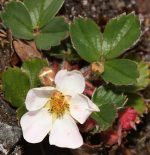 Also called scarlet or Virginia strawberry, this herbaceous perennial is a member of the rose family, Rosaceae, that also includes apples, lady’s mantle, and pyracantha. It is native to eastern North America from Newfoundland west to South Dakota and south to Florida and Oklahoma where it grows in meadows, fields, prairies, woodland edges, and roadsides. A cool weather plant, wild strawberry grows up 3-9” tall and spreads indefinitely by stolons, forming large colonies when conditions are favorable. The trifoliate leaves are carried on petioles up to 6” long and have 3 coarsely toothed leaflets up to 2.5” long. The white flowers have five petals and many stamens with yellow anthers. They are ¾” across and carried in flat umbel-like clusters of 4-6 flowers in spring. The fruits are achenes and look like seeds on a “berry” that is actually a fleshy receptacle. Plants like full sun to part shade, and fertile, moist to dry, well drained soils; they do poorly in high humidity. The genus name Fragaria comes from the Latin word fragro meaning smell sweet and refers to the fragrance of the fruit. The specific epithet, virginiana, refers to the place where the plant was first observed. The common name, strawberry, was derived from the practice of mulching the plants with straw to avoid fungal diseases.
Also called scarlet or Virginia strawberry, this herbaceous perennial is a member of the rose family, Rosaceae, that also includes apples, lady’s mantle, and pyracantha. It is native to eastern North America from Newfoundland west to South Dakota and south to Florida and Oklahoma where it grows in meadows, fields, prairies, woodland edges, and roadsides. A cool weather plant, wild strawberry grows up 3-9” tall and spreads indefinitely by stolons, forming large colonies when conditions are favorable. The trifoliate leaves are carried on petioles up to 6” long and have 3 coarsely toothed leaflets up to 2.5” long. The white flowers have five petals and many stamens with yellow anthers. They are ¾” across and carried in flat umbel-like clusters of 4-6 flowers in spring. The fruits are achenes and look like seeds on a “berry” that is actually a fleshy receptacle. Plants like full sun to part shade, and fertile, moist to dry, well drained soils; they do poorly in high humidity. The genus name Fragaria comes from the Latin word fragro meaning smell sweet and refers to the fragrance of the fruit. The specific epithet, virginiana, refers to the place where the plant was first observed. The common name, strawberry, was derived from the practice of mulching the plants with straw to avoid fungal diseases.
Wild strawberries were described in 1608 by George Percy when he explored the area near Point Comfort on the Chesapeake Bay. In 1629 the London apothecary and king’s botanist to Charles I, included it in his work Paradisi in Sole, Paradisus, a book describing almost a thousand plants. Eventually, the wild strawberry was crossed with a Chilean strawberry to produce the berries we now enjoy today with the taste of the former and the size of the latter.
Photo Credit: Wikipedia